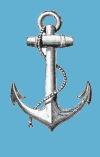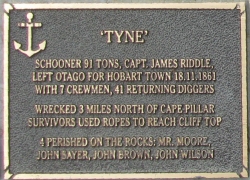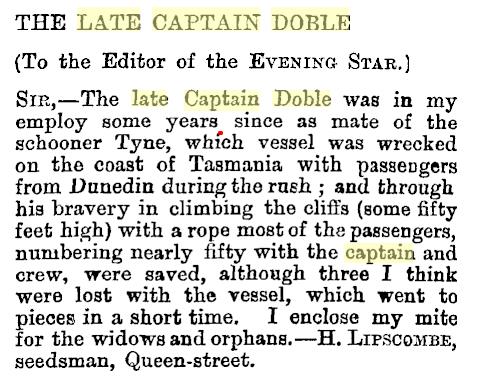 |
Tasmanian Seafarers' Memorial
|
 |
Schooner 'Tyne' (1861)
The plaque reads ...
 'TYNE'
'TYNE'
Schooner 91 tons, Capt James Riddle,
left Otago for Hobart Town 18.11.1861
with 7 crewman, 41 returning diggers.
Wrecked 3 miles north of Cape Pillar
survivors used ropes to reach cliff top
4 perished on the rocks: Mr.Moore,
John Sayer, John Brown, John Wilson
On Friday 6 December 1861 the Hobart newspaper, The Mercury reported that the schooner Tyne left Otago in New Zealand bound for Hobart having on board 41 passengers and a crew of 7 men . The Tyne had experienced heavy weather during the passage but experienced light winds that barely gave her steerage way finally causing the ship to drift side on to rocks three miles north of Cape Pillar.
WRECK OF THE SCHOONER TYNE - FOUR LIVES LOST.
Reference: WRECK OF THE SCHOONER TYNE—FOUR LIVES LOST. (1861, December 6). The Mercury (Hobart, Tas. : 1860 - 1954), p. 2. Retrieved December 11, 2014, from http://nla.gov.au/nla.news-article8802759
The steamer Cullodon which arrived from Port Arthur at two p.m. yesterday, brought up the captain, crew, and portion of the passengers of the schooner Tyne, which vessel was wrecked on Tuesday morning last, about three miles to the northward of Cape Pillar. From the ship's log it appears that the schooner Tyne left Otago for this port on the 18th November, having on board 41 passengers and a crew of 7 men. During the first part of the voyage the schooner experienced strong west and north-west winds, and on the 3rd inst., she was 68 miles from Cape Pillar bearing W. by N. In the afternoon of the same day it blew hard from the N.E., with thick weather and heavy rain, the schooner steering West 64 miles. At 8 p.m. by calculation, Cape Pillar bore N. half W. ten miles, the wind falling light. At 10 p.m. saw the land ahead, distance about three miles. The wind shifting to the S.E., very light, with a strong easterly swell, wore ship, vessel heading from N.E. to E.N.E., with scarcely steerage way. The wind continuing very light the vessel drifted on shore, and at 2.30 a.m. (3rd instant), she struck with her keel and drove broadside on to the rocks, about three miles to the north of Cape Pillar, and commenced breaking up. At 4 p.m. she was a total wreck. The passengers and crew, excepting four who endeavoured to swim ashore and were killed by being dashed up against the rocks, escaped, by a rope which the mate succeeded, in a most courageous manner, in taking and fastening to the top of the cliffs, which at this particular spot are about 200 feet high, and nearly perpendicular. From the vessel the passengers and crew first got on to a ledge, whence they either hauled themselves up or were drawn up to the top of the cliffs, many of them being so exhausted with the exertion that they were unable to stand upon reaching the spot of safety. So great was the difficulty of getting all hands up the cliffs that it was 3 p.m. before they were all safe. Captain Biddle and all hands then went through the bush in the direction of Port Arthur. After wandering about all that night they arrived opposite to Port Arthur, in a very exhausted state, on Wednesday afternoon, and having lighted some fires, which were observed from the settlement, the Commandant sent two boats over and took them into Port Arthur, where they received every attention. Besides the poor unfortunate men who were drowned, one of the passengers, John Smith, the first man safe ashore, and who went in search of relief, lost himself in the bush, and although every exertion was used to discover him, no traces of him had been found up to the time of the steamer's leaving yesterday. The Tyne, schooner, 91 tons register, was commanded by Captain Riddle, owned by Mr. H. Lipscombe, and was insured for £700: a sum considerably below her value at the present time. We append the names of the survivors : - F. W. Tucker, John McQueen, William Burridge, Charles Glover, William Sayers, Edward Ralph, Edward Pertin, Stephen and George Griffiths, Edward Bowls, John Smith, James Johnson, James Smith, William Collins, Robert Brown, Geo. Parsons, William Howe, Adam Hodgins, Alfred O'Connor, T. S. Risby, James Brattan, James Sculthorpe, H Simpson, - Moore, Frederick Young, William Hurd, William Dickson, John Jackson, George Young, Frederick Rickers, Benjamin Collins, Peter Walsh, Thomas French, William Robertson, and Edward Henry Miller. The names of the drowned were - Moore, an elderly man, and John Soyer, both residents of Hobart Town, John Brown, (Longford) and John Wilson. Immediately on its becoming known at the race course, yesterday, that so many shipwrecked individuals, many belonging to the northern side of the island, had arrived in Hobart Town and were in distress, a subscription list was opened at the suggestion of Mr. Manning, Mr. Chapman, and others, and nearly £50 was subscribed. Fourteen of the sufferers were enabled to return to their homes in the North by last night's coaches. Soon after their arrival in town yesterday the sufferers met at the Custom House Tavern and presented an appropriate address to Captain Riddle and his chief officer, to whose presence of mind and good management they one and all admitted that they owed their lives.
A Letter to the Editor that appeared in the Auckland Star newspaper on 31 July 1875 identified the Tyne's mate/chief officer as Robert Doble who was the 'hero' credited with saving all passengers and crew but four on board.

![]()